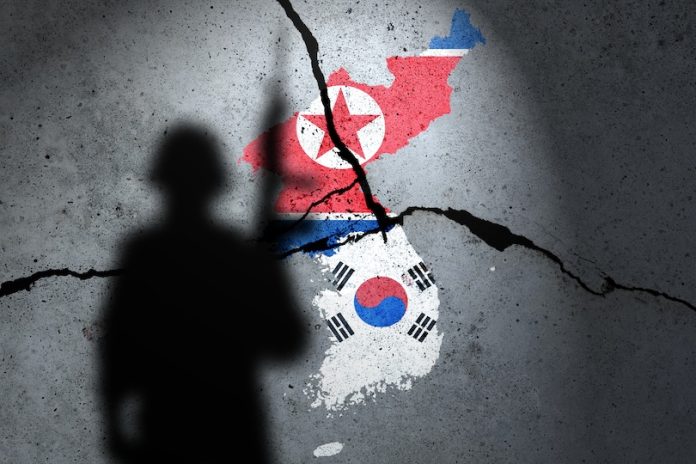Amidst the growing U.S. rift with various allies in Europe and even the Indo-Pacific, such as Japan and Australia, South Korea must reassess its national security. With North Korea ever more emboldened, South Korea must prepare concrete contingencies to defend the country from future war. As large scale threats grow in Europe, the Middle East, and the Indo-Pacific—particularly on the Korean Peninsula—Seoul should adopt a new foreign policy of strategic ambiguity toward Pyongyang, keeping the North guessing what the Republic’s future moves could be.
Russia’s full-scale invasion of Ukraine in 2022 changed foreign relations for the better and worse, as many of the world’s top military powers reassessed national security concerns. Under the Biden Administration, relations improved with South Korea, and historical summits between Washington, Seoul, and Tokyo occurred. However, the slow trickling of military aid to Ukraine and then-President Biden’s lack of concrete strategy made countries worry if America would truly back its allies. Those fears so far have come to fruition under President Trump, who not only indefinitely cut off military aid to Ukraine but whose cabinet has engaged in diplomatic incidents in both Europe and Asia. The administration has gone so far as to question the will of other countries who fought and bled alongside Americans, such as Britain, France, and Japan.
Already suffering from political turbulence in the aftermath of former President Yoon’s attempted coup and martial law, Seoul should also be wary of the lack of American indecisiveness towards its allies, even when the US-ROK alliance remains steadfast. While the U.S. and its allies remain in the fluctuation of steadfast support and diplomatic conflicts, its adversaries become more emboldened by the day, and one of the primary beneficiaries of American indecisiveness is North Korea. Not only has Pyongyang self-sabotaged reunification efforts with Seoul, but the Kim regime is also actively preparing for an armed conflict. During the past couple of years, North Korea has ramped up ballistic missile tests and drone production and ordered the Korean People’s Army (KPA) to have capabilities for war. Furthermore, Pyongyang is now a direct belligerent in Russia’s invasion of Ukraine, both through logistics and boots on the ground.
In the late Autumn of 2024, North Korea sent several thousand KPA contingents to Russia to use their operations to take back the Kursk region, in which Ukraine established a foothold that same summer. Wanting combat experience and valuable data, the KPA rushed forward at any chance during assaults, albeit taking heavy casualties due to a lack of experience and language barriers with Russian forces. Despite significant casualties, KPA troops helped Russian forces enough to regain the Kursk region, and DPRK forces could take part in further operations inside Ukraine if requested. Furthermore, North Korean troops will come back with combat experience against South Korea—which will ring alarms in Seoul.
Amidst North Korea’s rising capabilities and political turmoil in the South and the United States, Seoul must prepare for possible provocations by Pyongyang, which could test the waters of American commitments to its allies, which have fractured the past several months. However, South Korea could counter a potential surprise attack from the North by potentially moving forward with plans for nuclear deterrence. Initially, in the 1970s, South Korea started to develop nuclear weapons, and historically, society saw their use in a positive manner that ended brutal Imperial Japanese rule. Under U.S. pressure, Seoul ceased nuclear ambitions fully under the 1992 Summit, but Pyongyang continued to secretly proliferate until it achieved nuclear weapons itself in the late 90s, nonetheless.
The tide of the world has since changed as Russia has strong-armed the world over the past few years with nuclear threats, which its new security partner, North Korea, would attempt to replicate over the Korean Peninsula. Suppose Ukraine were to be forced to cede territory over the threat of Russian nuclear weapons hitting Europe and America. What could stop the same thing if China conducted the same strategy towards Taiwan, Japan, or the South China Sea and North Korea to South Korea?
Growing alliance shifts could make Seoul reassess whether Washington would protect the Republic with a counterattack if the North launched a first strike. For this reason, arguments are being made for a potential independent proliferation program. Nevertheless, if the ROK’s government moves forward with a program, there will be questions and concerns. Firstly, if the production of nuclear weapons takes place, North Korea would realize it would lose its edge on weapons of mass destruction. Because of those fears, Pyongyang may be inclined to conduct military and clandestine operations to stop a new program in Seoul. South Korea’s government could also face international pressure and further diplomatic coercion by the United States to hinder a program. Lastly, former President Yoon’s actions showed the need for further checks and balances, as his actions nearly led to not only a renewed military dictatorship in South Korea’s history but also a potential all-out war. Fears of another rogue and despotic government, this time with nuclear weapons, could stoke fears and contingency planning towards proliferation.
Despite domestic challenges, growing regional threats, and turbulence among allied partners, South Korea can maintain its edge in defense and deterrence by officially enacting strategic ambiguity as its foreign policy progresses. Pyongyang and much of the world see Seoul as a rational actor who would never commit the unthinkable. Even when Yoon attempted to enact martial law, South Korean citizens and parliament fought back—but what if the government capitalized on this with the North? North Korea and Russia are directly benefiting from the unwillingness of various nations to confront their belligerent actions with empty words and hollow rhetoric—which South Korea was intertwined in as the KPA gained major combat experience in Kursk. With strategic ambiguity, Seoul could keep Pyongyang guessing if it will or will not decide to pursue its independent nuclear program. Still, this type of foreign policy would have to include breaking norms.
South Korea should open up its long taboo over weapons exports to Ukraine as North Korea becomes more intertwined with the war. The South Korean government should make it clear the DPRK will be confronted anywhere at any time of their choosing. While maintaining top-level diplomacy and soft power, Seoul should carry a foreign policy equivalent to Teddy Roosevelt’s, with ambiguity regarding future movements. This could dislodge the Kim regime from plans as it tries to decipher what the ROK is planning. In a world of ever-changing alliances, regional wars in Europe and the Middle East, and brewing conflicts in the Indo-Pacific, South Korea should prioritize strategic ambiguity as a foreign policy priority. By matching or eclipsing North Korea’s unpredictability, Seoul can match its top existential threat while restoring domestic democratic order.
Further Reading on E-International Relations




